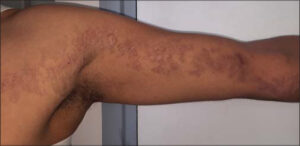Lichen striatus or Blaschkitis: About a new observation
Najoua Ammar , Laila Benzekri, Kawtar Znati, Karima Senouci
, Laila Benzekri, Kawtar Znati, Karima Senouci
Department of Dermatology and Venereology, CHU Ibn Sina, Mohammed V University, Rabat, Morocco
Citation tools:
Copyright information
© Our Dermatology Online 2023. No commercial re-use. See rights and permissions. Published by Our Dermatology Online.
Sir,
Blaschkitis(BL) is a rare acquired inflammatory dermatosis, which follows the lines of Blashko, of unknown etiology and has many similarities with lichen striatus (LS).
We report a new observation of blachkitis with histologic features of lichenoid dermatitis and A 36-year-old patient, without any notable history, consulted for lesions of the left hemisphere, which had been progressively developing for four years.
Clinical examination revealed maculopapular, locally verrucous, non-atrophic and pruritic lesions. The lesions followed Blaschko’s lines on the left hemithorax stopping at the anterior midline (Fig. 1). On the limbs, they went down sinuously along the left upper limb. The phanera and mucosa were normal. The suspected diagnoses were linear inflammatory verrucous epidermal hamartoma, blaschkolinear lichen planus, lichen striatus or blaschkite.
Histopathological examination had shown acanthosis and orthokeratotic hyperkeratosis of the epidermis with images of exocytosis and spongiosis of basal layers associated with interface dermatitis.
All these elements were in favor of a blaschkite. The patient was treated with topical tacrolimus. After three months of treatment, there was an improvement of the papular lesions, but sequellar pigmented macules persisted.
The term adult blashkitis was first introduced by Grosshans and Marot, in 1990 to describe a cutaneous rash smilar to LS in an adult [1]. Blaschkitis affects adults preferentially, it it appears as a papulo-vesicular eruption most often located on the trunk and which follows a spontaneously favorable evolution with frequent relapses histology is in favor of a spongiotic dermatitis[2]. on the other hand, lichen striatus is most often seen in children and is rarely seen in adults, it more frequently located on the limbs as a papular rash without vesicles. With a slower resolution, leaving a transient hypopigmentation. Recurrences are rare [3,4]. histological analysis shows both lichenoid and spongiotic dermatitis characteristics. Keegan et al. In 2007 were able to conclude that these two dermatoses are different in their clinical presentation and histopathology [5]. They presented differentiation characteristics between LS and BL. In contrast, Hofer proposed that because of the lack of distinctive clinical and histological caracteristics, BL and LS may be the same [6]. Finally, Müller et al support the theory that lichen striatus and blachkitis are two clinically and histologically close entities that belong to the same spectrum of blashkoline dermatosi, and suggests to continue to use both terms (LS and BL, in order to achieve a simpler diagnosis [7].
Overlap of clinical and histological caracteristics between LS and BL is not rare suggesting that these two entities are different expressions of the same process.
Consent
The examination of the patient was conducted according to the principles of the Declaration of Helsinki.
The authors certify that they have obtained all appropriate patient consent forms, in which the patients gave their consent for images and other clinical information to be included in the journal. The patients understand that their names and initials will not be published and due effort will be made to conceal their identity, but that anonymity cannot be guaranteed.
REFERENCES
1. Grosshans E, Marot L. [Blaschkitis in adults]. Ann Dermatol Venereol. 1990;117:9–15.
2. Al-Balbeesi A. Adult blaschkitis with lichenoid features and blood eosinophilia. Cureus. 13:e16846.
3. Mun JH, Park HJ, Kim HS, Kim SH, Ko HC, Kim BS, et al. Lichen striatus occurring after allogenic peripheral blood stem cell transplantation in an adult with aplastic anemia. Ann Dermatol. 2012;24:87-9.
4. Ishikawa M, Ohashi T, Yamamoto T. Lichen striatus following influenza infection. J Dermatol. 2014;41:1133-4.
5. Keegan BR, Kamino H, Fangman W, Shin HT, Orlow SJ, Schaffer JV. Pediatric blaschkitis:expanding the spectrum of childhood acquired Blaschko-linear dermatoses. Pediatr Dermatol. 2007;24:621-627.
6. Hofer T. Lichen striatus in adults or 'adult blaschkitis’?There is no need for a new naming. Dermatology. 2003;207:89–92.
7. Darsha AK, Cohen PR. Blaschkolinear Acquired Inflammatory Skin Eruption (BLAISE):Case report of a young man whose dermatosis had features of lichen striatus and blaschkitis. Cureus. 2020;12:e10785.
Notes
Request permissions
If you wish to reuse any or all of this article please use the e-mail (brzezoo77@yahoo.com) to contact with publisher.
| Related Articles | Search Authors in |
|
|





Comments are closed.